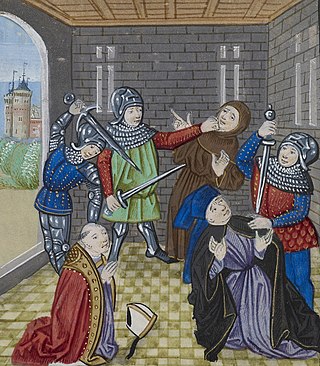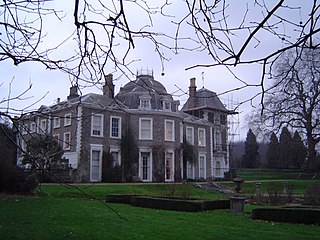
Hadlow is a village and civil parish in the borough of Tonbridge and Malling in Kent, England. It is situated in the Medway valley, north-east of Tonbridge and south-west of Maidstone.
A preceptor is a teacher responsible for upholding a precept, meaning a certain law or tradition.

Sir Robert Hales was Grand Prior of the Knights Hospitaller of England, Lord High Treasurer, and Admiral of the West. He was killed in the Peasants' Revolt.

Oxon Hoath is a Grade II* listed Châteauesque-style former manor house with 73 acres of grounds at West Peckham, Kent. The spellings Oxenhoath, Oxen Hoath and Oxonhoath are common alternatives. The manor is a former royal deer park. Oxon Hoath has been the seat of two baronetcies, and of five High Sheriffs of Kent. It has a surviving example of parterre gardens in its grounds.

Torphichen Preceptory is a church in the village of Torphichen, West Lothian, Scotland. It comprises the remains of the preceptory (headquarters) of the Knights Hospitaller of the Order of St John of Jerusalem in Scotland. The placename may be Gaelic in origin, e.g., "Tóir Féichín" or Brythonic, e.g., modern Welsh "tref fechan". The name "Tóir Féichín" with its Gaelic reference to the Boundary/Sanctuary stones set one mile around the village is most likely the true meaning of the village and Preceptory name rather than the modern Welsh which has no historical precedent that overrides the true meaning of those Neolithic sanctuary stones.

East Peckham is a village and civil parish in Kent, England on the River Medway. The parish covers the main village as well as Hale Street and Beltring.

Stalisfield is a village in the borough of Swale in Kent, England, located on a secondary road about 1½ miles (2.4 km) north of Charing and 5 miles south west of Faversham. The parish includes the hamlet of Stalisfield Green.

Oare is a village and civil parish north of Davington, Faversham in southeast England. It is separated from Faversham by the Oare Creek. To the north of the village are the Oare Marshes, and the Harty Ferry which once linked to Harty on the Isle of Sheppey. Kent Wildlife Trust manages a nature reserve that is an important stopping place for migratory birds.
West Peckham is a village and civil parish in the borough of Tonbridge and Malling in Kent, England. The River Bourne flows through the extreme west of the parish, and formerly powered a paper mill and corn mill. The Wateringbury Stream rises in the parish. Oxon Hoath is the former manor house of West Peckham.

The River Bourne rises in the parish of Ightham, Kent and flows in a generally south easterly direction through the parishes of Borough Green, Platt, Plaxtol, West Peckham, Hadlow, and East Peckham where it joins the River Medway. In the 18th century the river was known as the Busty or Buster, the Shode or Sheet, but is not known by these names nowadays. A bourne is a type of stream, while shode means a branch of a river.

St John's Jerusalem or Sutton-at-Hone Preceptory is a National Trust property at Sutton-at-Hone, Kent, England which includes the 13th century chapel of the Knights Hospitaller and a garden moated by the River Darent. The chapel and garden are open to the public.
Sir John Rivers was a Tudor-era businessman who became Lord Mayor of London.

Swingfield Preceptory was a priory about 5 miles north of Folkestone, Kent on the south coast of England.

St Mary's Church is the parish church in Hadlow, Kent, United Kingdom. The church is a Grade II* listed building.

St Lawrence's Church is an Anglican parish church at Mereworth, Kent, United Kingdom. It is in the deanery of West Malling, the Diocese of Rochester and Province of Canterbury. The church was built in the mid-1740s by John Fane, the 7th Earl of Westmorland, following his removal of the village's 12th century place of worship to allow for the enlargement of Mereworth Castle.
James Peckham was an English politician.

St Mary the Virgin is a small parish church in Thurnham, Kent. Begun in the 12th century, it is a Grade I listed building.












